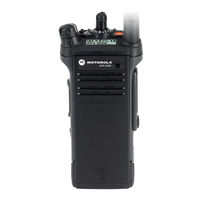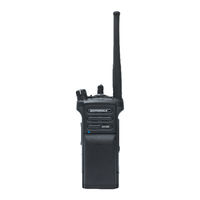Motorola APX 6000Li Manuals
Manuals and User Guides for Motorola APX 6000Li. We have 6 Motorola APX 6000Li manuals available for free PDF download: User Manual
Motorola APX 6000Li User Manual (160 pages)
Brand: Motorola
|
Category: Two-Way Radio
|
Size: 2.59 MB
Table of Contents
-
-
Status Icons30
-
Alert Tones36
-
-
-
Viqi50
-
Contacts58
-
Scan Lists62
-
Scan65
-
Recent Calls67
-
Quik Call II70
-
Fireground77
-
Logging out83
-
Hear Clear99
-
Radio Lock100
-
Radio Stun102
-
Using Radio Stun102
-
Radio Kill102
-
Radio Inhibit103
-
Location104
-
Location Format105
-
MGRS Coordinates105
-
Smartconnect113
-
Site Search114
-
Holster Sensor119
-
Wi-Fi127
-
Utilities128
-
Transmit Inhibit135
-
Advertisement
Motorola APX 6000Li User Manual (174 pages)
Model 3
Brand: Motorola
|
Category: Two-Way Radio
|
Size: 1.64 MB
Table of Contents
-
Disclaimer18
-
-
Alert Tones47
-
-
-
Selection69
-
-
Contacts71
-
Scan Lists78
-
Scan80
-
Man down90
-
-
-
-
Hear Clear118
Motorola APX 6000Li User Manual (146 pages)
MODEL 2
Brand: Motorola
|
Category: Two-Way Radio
|
Size: 1.51 MB
Table of Contents
-
Disclaimer
16 -
-
-
-
Contacts
60 -
Scan Lists
63 -
Scan
65 -
Man down
75 -
-
Advertisement
Motorola APX 6000Li User Manual (110 pages)
Brand: Motorola
|
Category: 2-way radio
|
Size: 3.54 MB
Table of Contents
-
Disclaimer16
-
Securenet18
-
Status Icons31
-
Alert Tones36
-
Scan Lists48
-
Scan49
-
Fireground55
-
Man down58
Motorola APX 6000Li User Manual (106 pages)
Brand: Motorola
|
Category: Two-Way Radio
|
Size: 3.21 MB
Table of Contents
-
Disclaimer18
-
Securenet20
-
Status Icons34
-
Alert Tones39
-
Scan Lists49
-
Scan50
-
Only)57
-
Man down58
Motorola APX 6000Li User Manual (96 pages)
Model 1
Brand: Motorola
|
Category: Two-Way Radio
|
Size: 1.23 MB
Table of Contents
-
Disclaimer
16 -
-
-
-
Scan Lists46
-
Scan47
-
-
Man down
56 -





